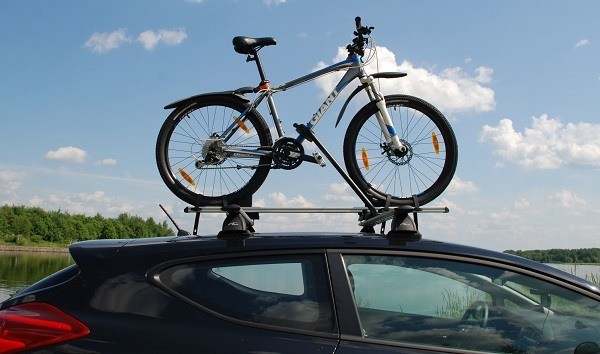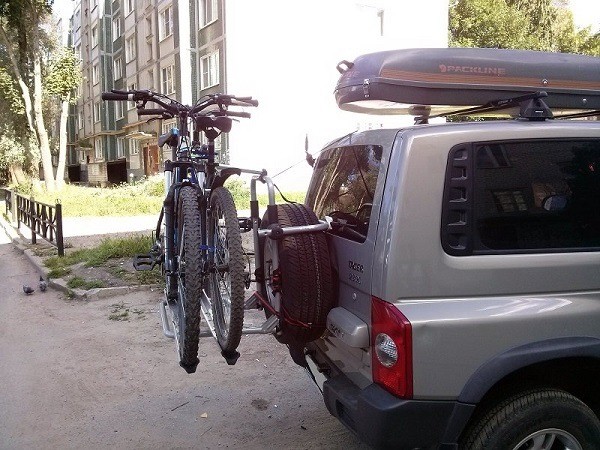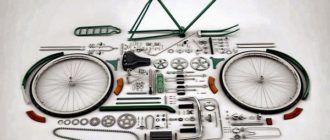As spring arrives, the number of cyclists is increasing. And only true fans of two-wheeled transport know what happiness it is to get out after the winter downtime and rush forward towards new horizons and amazing places. But cyclists are different: if most are limited to short trips to the nearest woods or short strolls within 50 km from home, there are real gourmets who can’t go on a trip without a bike. Such get into the car, mount the bike and go towards new adventures and exciting routes. That’s where the quite logical question arises: how to carry a bike in the car? It’s worth saying at once: there are an obscene number of options. You can just put a bike in the trunk or back of the passenger seat, you can use a special mount for transporting bicycles on the roof of the car, you can attach it to the spare – in general, the field for flight of fancy is limitless. Here’s the rub is which of these options is correct, reliable and will not cause questions from traffic police officers. Today let’s briefly discuss the options for transporting a bicycle in the car and tell you which of them is the most appropriate.
When you need to transport your bicycle in a car
Transporting a bicycle in a car is not as rare a situation as it may seem at first glance. Elementary: you wanted to go to the countryside for a month to take a break from the bustle of the city. To get to your destination by bike is impossible, because it is far away. That is the first reason. And these situations, when you need to transport a bike in the car, there can be a huge variety:
- There is no desire to pedal in a dense stream of cars (especially true for weekends, when city dwellers are torn outside the city).
- When the only road to get to the riding area is the freeway. And we know that it is forbidden to ride a bike on it.
- If you’re on your way to a competition or still decide to go out of town as a family.
- If you decide to ride cross-country or arrange a test drive for your bike.
In general, situations when you need to transport your bike in the car, there really are a lot. Regardless of where and why you are going, you need to consider the fact that the bike must be transported in accordance with certain rules and standards. At least this will help avoid problems with traffic police officers. You can easily transport your bike in the cabin or trunk of the car. To do this, it is enough to know how to disassemble the bicycle for transportation in the car.
Ways to transport your bike in the car
We will definitely talk today about how you can carry a bicycle in the cabin of the car or the trunk. But it’s worth saying right off the bat that both of these options are, at a minimum, uncomfortable and, at a maximum, unsafe. And here’s why:
- Obvious inconvenience. The bike in the cabin (especially if it is not a folding model) takes up quite a lot of space, even if it is an SUV or station wagon. Yes, you can remove the wheels, but this is not the case when reducing the size will save the situation. Imagine that you are going on a long journey, and in addition to the driver, there are two more passengers with their belongings, bags and trunks. Do you think there will be still room in the cabin for a bicycle?
- Dangerous. It really isn’t safe to carry a bicycle in the cabin of a car. Much depends on how the bike will be “packed”. It can be placed on the rear seats, with the steering wheel against the backs of the front ones. Even at strong braking it will not fly out of its position. But if an accident … In this situation, the bike turns into an unpredictable shell, which can cause serious injury to the driver and passengers.
Therefore, the option of transporting the bike in the cabin can be relevant only for travel short distances. Also, such methods are suitable for those who do not know how to transport a bike in the car without a mount. If there is a long road, it is better to use standard methods of mounting. And now let’s break down the possible ways of transporting a bicycle by car.
In the trunk
This option is suitable if the luggage compartment of the car is not cluttered with bags, trunks, bags of potatoes and other items. If space allows, just put your bike in the trunk and go. For convenience and reliability, you can remove the front wheel and pedals, lower the saddle and turn the handlebars along the frame, pack the bike in a case and thus put it in the trunk.
If you’re not traveling alone and the trunk is busy, it’s best to consider other options for transporting your bike in the car without a mount.
Car roof mount
The most common and convenient option for transportation, provided that you use special fasteners and properly secure the bike on the roof. There are at least three things to consider:
- The bike does not interfere with other drivers, but keep in mind that the dimensions of your car have increased in height. Keep this in mind when driving into car washes, garages or tunnels.
- To mount your bike on the roof and secure it securely, you’ll have to do some work. Good if you have a regular passenger car. A little worse if you have a crossover. And quite badly, if the minivan: here without a stool is impossible.
- Observe a speed mode. It is clear, that a bicycle will not tear off a roof at a speed of 80-100 km/hour, but nobody cancelled sailing and risks of loosening of fasteners at high speed.
Experienced drivers-cyclists recommend that every 100-150 kilometers to check the status of fasteners and the reliability of construction. What are the mounts for bicycles on the roof of the car? As a rule, bikes are installed in an upright position, securing them to the crossbars of the upper trunk with special bicycle carriers. Cheap versions of such mounts are made of conventional painted steel. More expensive options are made of durable aluminum alloy: such, as a rule, have special locks to prevent theft of the bicycle.
You will probably be interested to know how much a bicycle carrier on the roof of the car costs. The price range is quite wide: from 1 to 15 thousand Russian rubles. The latest, most expensive models, according to manufacturers, hold the bike firmly, so it will not fly off even when riding at high speed on bumps or at sharp turns. How many bikes do you think you can carry on the roof of the car? If the mount is secure and the car roof is big enough, 3-4 bikes will easily fit.
Rear Door Mount
Here you need to consider where exactly the bike will be attached, in what way, whether these actions are legal in relation to other road users. Of course, for sure there will be curiosity, which quickly come up with how to fix the bike on the rear lid of the trunk by improvised means. You will use scotch tape, duct tape and rope. So do in any case can not be, because the ropes can floppy on the bumps and bumps. The consequences are unpredictable: at the minimum, your bike will be ruined, and at the maximum, it will fly into the windshield of an oncoming or passing car. And if the car damage can be covered by insurance, the human cost on your conscience is not covered by anything.
It is clear that the majesty of chance takes place here. But where is the guarantee, that it will not happen to you? So we will not take any risks, and understand the peculiarities of devices for transporting bicycles on the car. There are two types: for the back door and for the bumper. Cost such mounts are not cheap (the average price tag varies in the range of 5000 rubles), and you need to select them in accordance with the model of the car. It is worth saying right away that if you have a regular passenger car, then this option is definitely not suitable for you, because the mounts for the bike on the back door are ideal, as paradoxical as it may sound, just for cars that have that very back door. These are hatchbacks, station wagons, SUVs, minivans, crossovers. On the sedan, unfortunately, the device can not be installed.
Such a product has its own advantages: for example, the mount does not affect the aerodynamics of the car, unlike the transportation of a bicycle on the roof of the car. In addition, this method of transportation does not increase the dimensions of the car in height, does not block the view and does not distract other drivers. At the same time, there are also disadvantages:
- Increases the weight of the rear of the car;
- it is necessary to remove the spare tire in SUVs;
- Limited access to the trunk.
There is also a risk of killing the bike in the trash, even in a small accident.
Bicycle carrier for the spare tire
Of course, this option is only suitable for SUVs and minivans. It’s worth saying right away that the mount is not the cheapest, but it has quite a few advantages:
- Does not block access to the trunk.
- Allows you to secure your bike.
- No need to re-hang the license plate.
- Does not increase the size of the car.
This is essentially similar to the previous option, only with restrictions on auto models. Mounting the bike on the spare tire is more convenient than packing the bike on the back door.
A towbar mounting bracket.
This is almost exotic. However, this option is becoming more and more popular. Whether it’s a tribute to fashion, or it’s really convenient. Let’s take a closer look at this beauty and we shall try to find some pitfalls in it. And they are certainly to be found here.
So, a special towbar mounting bracket for bicycle transportation is a construction with clamps and holders for one and in extreme cases for 2 or 3 bikes. The price tag on simple models starts at 300 rubles. The most advanced products, made in accordance with the rules of traffic regulations (there are special platforms for bicycles, turn signals and lights, as well as a support for the license plate with lights), will cost much more. But no traffic police inspector will not be able to get to you!
Possible fines and problems on the road
First of all, we want to focus attention on a possible problem that occurs when attaching a bicycle to the back of the car or a spare wheel: the license plate. It must be open! If the mounting structure together with the bikes obscures the view, you need to re-hang the sign in a prominent place. Remember that the attached bicycle must not interfere with the movement of cars in the general flow.
As life practice shows, most traffic police officers are not particularly picky about the place of attachment of the bicycle. It is important only that the two-wheeled vehicle was securely fixed with a special, not homemade mount.
Recommendations
Comparing the possible options for fixing the bike for the car, we can say that the optimal and best is the transportation of the bike on the roof of the car. It is enough to see once crumpled racing bikes, the total cost of which may exceed the cost of a not bad car, to understand: mount the back, on the spare tire or towbar – not a good option.
When transporting your bike in inclement weather, make sure to shelter it from the rain. The first time you put your bike on the roof, get a stool and a cover (a blanket, an old mattress, or a beach towel): you’re unlikely to get it right the first time you ride it. You can damage the car’s paintwork and severely fatigue your hands.
Conclusion
As you can see, there are no special problems with the transportation of the bike in the car. The main thing is to securely fasten your iron friend with special fasteners. If the trip is not a long distance and space allows, you can safely transport the bike in the cabin or the trunk. It is not even necessary to disassemble the bike.












